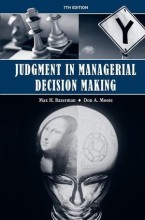Summary: Stuvia 1078607 Samenvatting Behavioral Finance 2
- This + 400k other summaries
- A unique study and practice tool
- Never study anything twice again
- Get the grades you hope for
- 100% sure, 100% understanding
Read the summary and the most important questions on Stuvia 1078607 samenvatting behavioral finance 2
-
1 Lecture 1 – Introduction
This is a preview. There are 16 more flashcards available for chapter 1
Show more cards here -
What are the three decision-making perspectives discussed?
- Normative: focuses on how people should make decisions, such as using NPV for project evaluation.
- Descriptive: examines how people actually make decisions, including biases like systematic deviations.
- Prescriptive: looks at how to help people make decisions effectively. -
What are the standard assumptions of traditional finance theory?
- Investors and managers perfectly resemble the Homo Economicus.
- Markets are considered perfect and informationally efficient.
- Financial incentives can correct suboptimal behavior, and passive investing in low-cost diversified index funds is deemed optimal. -
What are the implications of the Efficient Market Fanatic view on market efficiency?
- Belief that security prices always equal intrinsic value.
- Claims it's impossible to accurately predict risk-adjusted returns. -
What are the beliefs of the Behavioural Finance Fanatic regarding market efficiency?
- Argues that stock prices are solely influenced by market psychology.
- Maintains it's easy to predict movements in stock prices. -
What is the concept of the Homo Economicus in finance theory?
- Homo Economicus is described as a self-regarding maximizer with unlimited information processing and strong willpower. -
What is Homo Sapiens known as, and what are its characteristics?
- Homo Sapiens are known as "wise men" but exhibit characteristics of [bounded rationality], [awareness], [willpower], and [self-interest].
- Despite being called "wise men," they display limitations in rationality, awareness, willpower, and self-interest. -
Why did traditional finance theory emerge and persist?
- Traditional finance theory emerged and persists due to factors such as the [desire for natural sciences], rise of computers, "as if" defense by Friedman, and belief in "market forces solving irrationalities."
- It emerged and sustains due to reasons like a desire for scientific credibility, technological advancements, theoretical defenses, and faith in market efficiency. -
What is behavioral finance and what is its approach?
- Behavioral finance (BF) studies how psychological phenomena affect financial behavior, examining deviations from rationality and relaxing assumptions of perfect capital markets.
- BF extends traditional finance by looking at systematic deviations from rationality and relaxing the assumptions of perfect markets. -
2 Lecture 2 Overconfidence & Optimism
This is a preview. There are 33 more flashcards available for chapter 2
Show more cards here -
What are the beliefs associated with the Homo Economicus model?
- Utilizes all available information when marginal benefits surpass marginal costs.
- Maintains rational expectations avoiding systematic errors. -
What are the negative outcomes associated with overconfidence and optimism?
- Attributed to causing serious global issues like wars, fatal accidents, and wrongful convictions.
- In financial decision making, leads to stock market bubbles, unnecessary lawsuits, overleveraging, bankruptcies, excessive securities trading, and failed mergers/acquisitions.
- Simpler consequences include games of popularity poker and poor exam preparation.
- The graph demonstrates that people's confidence in their responses often exceeds accuracy, which can contribute to such negative outcomes.
- Higher grades + faster learning
- Never study anything twice
- 100% sure, 100% understanding
































